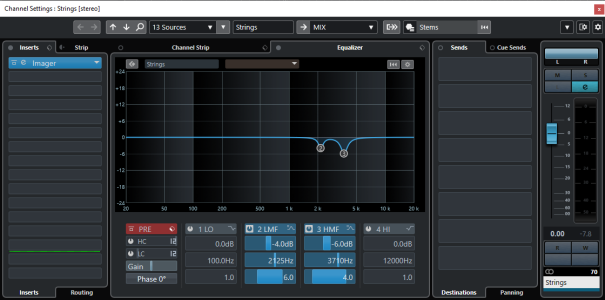This is a very useful thread already and I think I have some things to add in regard to CSS Strings:
* For mixing CSS strings I start with the default mic mix and then apply the Joel Dollie pro tipp. I learned it in a private session with him, but meanwhile it's also covered in one of his YT videos:
* As to the delay, this is certainly one of the more annoying traits of CSS, but I too found a quick workaround: I have hotkeys for moving MIDI events by 1 frame ("<" and ">"). Hitting "<" once is pretty much exactly what the short articulations need after quantizing to the grid.
* For the legato delay it's usually ~3 frames, even more for the advanced legato. For those who didn't know (I certainly didn't when I started out using CSS): The first note of the legato phrase pretty much sounds where it's at, it's only the notes coming after which are (considerably) delayed. And the delay is also depending on the velocity of the note, so having the same velocity for all notes of a phrase is usually a good idea.
* String runs: I don't know if this is the way, but I'm having good results by using the "marcato legato with spiccato overlay" articulation, keeping the velocity of the notes between 30 and 80 and accenting notes that are important harmony-wise (like 1sts, 5ths... depends on the mode you're in). If you break down your run in smaller parts, it's usually a good thing to accent the first note of each part. But iirc there's a thread covering this in detail already.
* Sustain/Tremolo/Trill Release: When I started using CSS I immediately shortened the release time of those articulations because they messed up my phrasing. Meanwhile I increased them again (I think around ~80) and I really appreciate the long release because it kind of emulates what string players do, letting notes "fade out". I learned though that I better use these articulations for textures, chords and supporting harmony, not for melodies.
* Articulation switching: This is a personal thing, but I like my template clean and compact, so I have one track for all articulations and I switch between them using sound variations in Studio One. You can download these via the Presonus exchange platform. I think I had to modify them after 1.7, but this isn't a big deal. If you want to use my updated ones, let me know, I'm sure it's possible to export and send them over.
Hope this helps and/or inspires. CSS is such a great library.





 The EQ removes the harshness that mostly comes from the high strings.
The EQ removes the harshness that mostly comes from the high strings.

